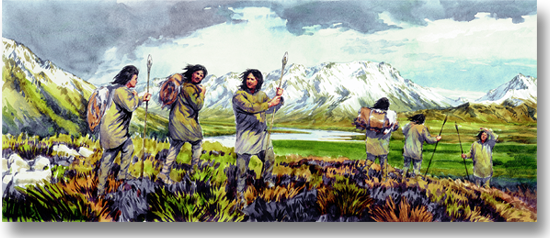
Read More about extinctions in the Museum's The Midwestern United States, 16,000 Years Ago.
Native Americans
The first people entered North America by 14,000 years ago and perhaps even earlier. They came from Asia. However, scientists are unsure of the routes these early groups of people took. One possibility is that they crossed the Bering Land Bridge and from there moved across Canada Through an ice-free corridor and spread throughout the United States and Mexico.
Another option is that they followed the coast to the Pacific Northwest. From there, they continued down the west coast and into the interior of the continent. These nomadic hunters and gatherers are called Paleo-Indians.
Connections - Humans Arrive
Scientists recognize a possible connection between the arrival of humans in North America and the extinction of some large animals. Mammoths, mastodonts, giant ground sloths, giant beavers, stag moose, and other large mammal species went extinct roughly 500–1,000 years after the arrival of humans. Artifacts and other evidence suggest Paleo-Indians were resourceful hunters.
While humans may be linked with the extinctions, other factors should also be considered. Climate changed greatly, and the resulting rapid changes in the environment may have stressed animal populations. Hunting, environmental change, and disease may all have played a role.